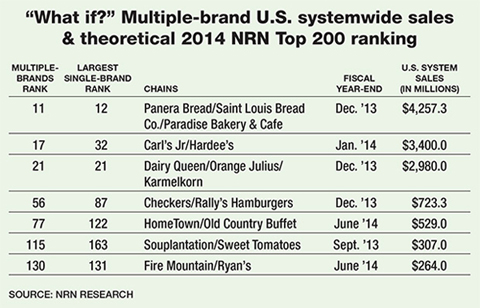
Panera Saint Paradise Cafe? Hardee Carl’s? Sweet Plantation?
Don’t worry if you’ve never heard of these large foodservice brands, as they are simply name collages I concocted to represent the extended restaurant families envisioned by some parent companies.
NRN’S Top 100, now in its 42nd year, and Second 100, which turned 20 in 2014, annually look at the 200 largest foodservice “chains” ranked by reported or estimated U.S systemwide food-and-beverage sales. For Top 200 purposes and, I think, among most consumers, a ‘chain’ is a brand, or group of similarly named establishments.
Some of the company representatives NRN contacts yearly for system sales performance updates have expressed a desire to show in chain tables the consolidated results of multiple groups of restaurants that share similar menu, décor and operational traits, but not the same name. These reps usually explain that, except for the signage on the door, the consumer experience and operational thrusts are virtually the same across such related businesses. Other contacts merely state that their group looks at an assortment of concepts, closely related or not, as a single business and that is how they would like results presented.
Though NRN has no plans to change its definition of ‘chain’ as a group of similarly named establishments for its core Top 200 census, I’ve compiled a table of some of the “What if?” alternative U.S.-systemwide-sales scenarios suggested by contacts in words or actions. Along with such group-sales calculations and the theoretical rankings associated with those numbers – should they have been included in the 2014 Top 200 qualifying sort – the table shows the actual 2014 Top 200 ranking for the largest single brand in each bunch.
So, for example, the Hardee’s-Carl’s Jr.’s combined results would have ranked No. 17 on the What if? roster, compared with the No. 32 solo ranking of the largest component, Hardee’s, in the published 2014 Top 200.
Among the entries showing sales for combined similar if not similarly named concepts, the greatest ranking improvement was realized by the Sweet Tomatoes-Souplantation pairing. The No. 163 ranking by Sweet Tomatoes, alone, was sweetened by 48 spaces, to No. 115, under a consolidated presentation.
Some Top 200 chain parent companies believe so strongly in such all-are-one views that they only report consolidated results, forcing NRN Research to estimate sales and units by like-named groups. Among them is Panera Bread. Co., which declines to publicly identify the sales or units of any one of its three brands: Panera Bread, Saint Louis Bread Co. and Paradise Bakery & Cafe.
As it turned out, there is an NRN-generated look at the aggregate worldwide systemwide sales of multiple chains owned by individual U.S. or Canada-based companies but it was not created for Top 200. That presentation is a supporting document of sorts for our International Top 25 report.
Our research partner for International Top 25, Euromonitor International, ranks its Top 25 companies headquartered outside of Canada and the United States based on all sales - franchisor and franchisee generated - by all the proprietary concepts owned by the companies in question. Our "Top 25: U.S.-Canada companies ranked by worldwide sales, growth" table was created to permit NRN users to compare the total portfolio output of the largest U.S.-Canada-based companies with that of their international peers.
Such an International Top 25 approach or definition of chain other than those that lump similarly named locations together run counter to the core U.S. Top 200 format and NRN's decades of research into domestic brand results. But that said, for the moment – and as a warm up for the new ways we’ll look at data outside our traditional Top 200 reports in 2015 – let’s glance over the What ifs? above and tip our hats to these formidable members of a fantasy roster.

